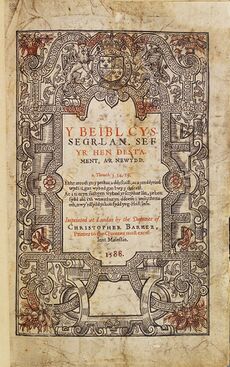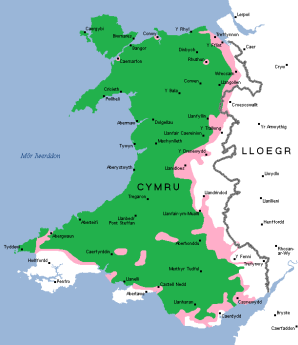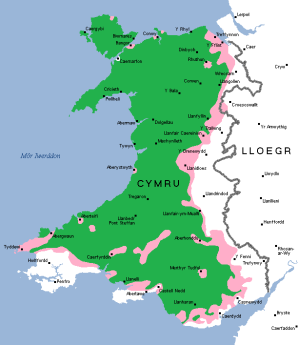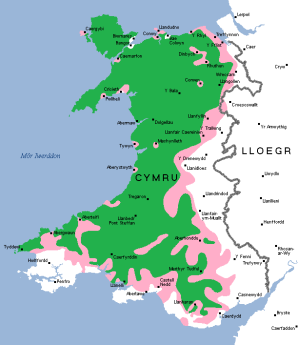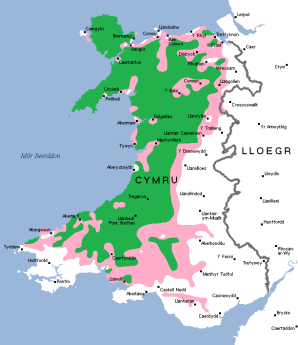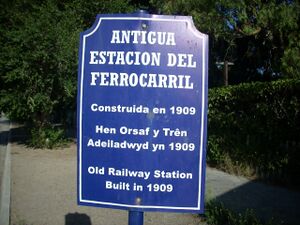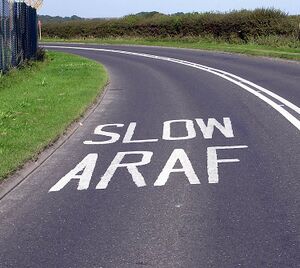لغة ويلزية
| الويلزية | |
|---|---|
| Cymraeg, y Gymraeg | |
| النطق | [kəmˈraːɨɡ] |
| المنطقة | United Kingdom (Wales, England), Argentina (Chubut Province) |
| العرق | Welsh |
الناطقون الأصليون | |
الصيغ المبكرة | |
| اللهجات | |
| Latin (Welsh alphabet) Welsh Braille | |
| الوضع الرسمي | |
لغة رسمية في | |
لغة أقلية معترف بها في | |
| ينظمها | Aled Roberts, the Welsh Language Commissioner (since 1 April 2019)[6] and the Welsh Government (Llywodraeth Cymru) |
| أكواد اللغات | |
| ISO 639-2 | wel (B) cym (T) |
| ISO 639-2 | wel (B) cym (T) |
| ISO 639-3 | cym |
| Glottolog | wels1247 |
| Linguasphere | 50-ABA |
| ثقافة ويلز |
|---|
 |
| التاريخ |
| الشعب |
|
|
الويلزية (Cymraeg كومريگ) هي لغة كلتية من الفرع البريطوني، ويتكلمها بعض أهل بلاد ويلز في غرب بريطانيا وبعض أهل وادي تشوبوت في منطقة باتاغونيا في الأرجنتين كلغة أٌم. هناك أيضا ناطقون بها في إنجلترا والولايات المتحدة وأستراليا وبلدان أخرى. الويلزية والإنجليزية هما اللغتان الرسميتان في ويلز.
الأصول
Middle Welsh
Middle Welsh (Cymraeg Canol) is the label attached to the Welsh of the 12th to 14th centuries, of which much more remains than for any earlier period. This is the language of nearly all surviving early manuscripts of the Mabinogion, although the tales themselves are certainly much older. It is also the language of the existing Welsh law manuscripts. Middle Welsh is reasonably intelligible to a modern-day Welsh speaker.
- Languages of Wales 1750 - 1900
Status
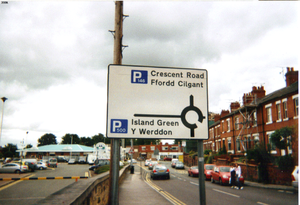
Vocabulary
Welsh supplements its core Brittonic vocabulary (words such as wy "egg", carreg "stone"), with hundreds of word lemmas borrowed from Latin,[7] such as (ffenestr "window" < Latin fenestra, gwin "wine" < Latin vinum). It also borrows words from English, such as (silff "shelf", giât "gate").
Phonology
The phonology of Welsh includes a number of sounds that do not occur in English and are typologically rare in European languages. The voiceless alveolar lateral fricative [ɬ], the voiceless nasals [m̥], [n̥] and [ŋ̊], and the voiceless alveolar trill [r̥] are distinctive features of the Welsh language. Stress usually falls on the penultimate syllable in polysyllabic words, and the word-final unstressed syllable receives a higher pitch than the stressed syllable.
Orthography
Welsh is written in a Latin alphabet of 29 letters, of which eight are digraphs treated as separate letters for collation:
- a, b, c, ch, d, dd, e, f, ff, g, ng, h, i, j, l, ll, m, n, o, p, ph, r, rh, s, t, th, u, w, y
In contrast to English practice, "w" and "y" are considered vowel letters in Welsh along with "a", "e", "i", "o" and "u".
The letter "j" was not used traditionally, but is now used in many everyday words borrowed from English, like jam, jôc (joke) and garej (garage). The letters "k", "q", "v", "x", and "z" are used in some technical terms, like kilogram, volt and zero, but in all cases can be, and often are, replaced by Welsh letters: cilogram, folt and sero.[8] The letter "k" was in common use until the 16th century, but was dropped at the time of the publication of the New Testament in Welsh, as William Salesbury explained: "C for K, because the printers have not so many as the Welsh requireth". This change was not popular at the time.[9]
The most common diacritic is the circumflex, which usually disambiguates long vowels, most often in the case of homographs, where the vowel is short in one word and long in the other: e.g. man ("place") vs mân ("fine, small").
Morphology
Dialects
Currently, there is no standardised or definitive form of the Welsh language, with significant differences in dialect marked in pronunciation, vocabulary and in points of grammar.
For example: consider the question "Do you want a cuppa [a cup of tea]?" In Gwynedd this would typically be Dach chi isio panad? while in the south of Dyfed one would be more likely to hear Ych chi'n moyn dishgled? (though in other parts of the South one would not be surprised to hear Ych chi isie paned? as well, among other possibilities). An example of a pronunciation difference is the tendency in some southern dialects to palatalise the letter "s", e.g. mis (Error: {{language with name/for}}: missing language tag or language name (help)), usually pronounced IPA: [miːs], but as IPA: [miːʃ] in parts of the south. This normally occurs next to a high front vowel like /i/, although exceptions include the pronunciation of sut "how" as IPA: [ʃʊd] in the southern dialects (compared with northern IPA: [sɨt]).
The four traditional dialects
Although modern understanding often splits Welsh into northern (Gogledd) and southern (De) 'dialects', the traditional classification of four Welsh dialects remains the most academically useful:
- Y Wyndodeg, the Gwynedd dialect
- Y Bowyseg, the Powys dialect
- Y Ddyfedeg, the Dyfed dialect
- Y Wenhwyseg, the dialect of Gwent and Morgannwg[10]
A fifth dialect is Patagonian Welsh, which has developed since the start of Y Wladfa (the Welsh settlement in Argentina) in 1865; it includes Spanish loanwords and terms for local features, but a survey in the 1970s showed that the language in Patagonia is consistent throughout the lower Chubut valley and in the Andes.
Registers
Modern Welsh can be considered to fall broadly into two main registers—Colloquial Welsh (Cymraeg llafar) and Literary Welsh (Cymraeg llenyddol). The grammar described is that of Colloquial Welsh, which is used in most speech and informal writing. Literary Welsh is closer to the form of Welsh standardised by the 1588 translation of the Bible and is found in official documents and other formal registers, including much literature. As a standardised form, literary Welsh shows little if any of the dialectal variation found in colloquial Welsh. Some differences include:
| Literary Welsh | Colloquial Welsh |
|---|---|
| Can omit subject pronouns (pro-drop) | Subject pronouns rarely omitted |
| More extensive use of simple verb forms | More extensive use of periphrastic verb forms |
| No distinction between simple present and future (e.g. af "I go"/"I shall go") |
Simple form most often expresses only future (e.g. af i "I'll go") |
| Subjunctive verb forms | Subjunctive in fixed idioms only |
| 3rd.pl ending and pronoun –nt hwy | 3rd.pl ending and pronoun –n nhw |
Amongst the characteristics of the literary, as against the spoken, language are a higher dependence on inflected verb forms, different usage of some of the tenses, less frequent use of pronouns (since the information is usually conveyed in the verb/preposition inflections) and a much lesser tendency to substitute English loanwords for native Welsh words. In addition, more archaic pronouns and forms of mutation may be observed in Literary Welsh.
Examples of sentences in literary and colloquial Welsh
| English | Literary Welsh | Colloquial Welsh |
|---|---|---|
| I get up early every day. | Codaf yn gynnar bob dydd. | Dw i'n codi'n gynnar bob dydd. (North) Rwy'n codi'n gynnar bob dydd. (South) |
| I'll get up early tomorrow. | Codaf yn gynnar yfory. | Mi goda i'n gynnar fory. (North) Wna i godi'n gynnar fory. (South) |
| He had not stood there long. | Ni safasai yno yn hir.[11] | Doedd o ddim wedi sefyll yno'n hir. (North) (D)ôdd e ddim wedi sefyll yna'n hir. (South) |
| They'll sleep only when there's a need. | Ni chysgant ond pan fo angen. | Fyddan nhw'n cysgu ddim ond pan fydd angen. |
The differences between dialects of modern spoken Welsh pale into insignificance compared to the difference between some forms of the spoken language and the most formal constructions of the literary language. The latter is considerably more conservative and is the language used in Welsh translations of the Bible, amongst other things - although the 2004 Beibl Cymraeg Newydd (Error: {{language with name/for}}: missing language tag or language name (help)) is significantly less formal than the traditional 1588 Bible. Gareth King, author of a popular Welsh grammar, observes that "The difference between these two is much greater than between the virtually identical colloquial and literary forms of English".[12] A grammar of Literary Welsh can be found in A Grammar of Welsh by Stephen J. Williams[13] or more completely in Gramadeg y Gymraeg by Peter Wynn Thomas.[14] (No comprehensive grammar of formal literary Welsh exists in English.) An English-language guide to colloquial Welsh forms and register and dialect differences is Dweud Eich Dweud by Ceri Jones.[15]
See also
- Association of Welsh Translators and Interpreters
- English and Welsh
- Honourable Society of Cymmrodorion
- Languages in the United Kingdom
- List of Welsh-language media
- List of Welsh films
- List of Welsh-language authors
- List of Welsh-language poets (6th century to c. 1600)
- List of Welsh people
- List of Welsh areas by percentage of Welsh-speakers
- Welsh literature
- St Benet's, Paul's Wharf
- Welsh Language Board
- Dal Ati
- Welsh placenames
- Welsh Tract
- Welsh (surname)
- Sindarin (A language invented by J. R. R. Tolkien for his legendarium – a body of literary works, mostly set in Middle-earth. The language was strongly influenced by Welsh.)
Notes
- ^ "Welsh language data from the Annual Population Survey: 2020". gov.wales. 7 April 2021.
- ^ Hywel Jones. "Estimation of the number of Welsh speakers in England" (PDF). calls.ac.uk.
- ^ Devine, Darren (2013-03-30). "Patagonia's Welsh settlement was 'cultural colonialism' says academic". Wales Online. Cardiff: Trinity Mirror. Retrieved 6 May 2017.
Now, though 50,000 Patagonians are thought to be of Welsh descent, the number of Welsh speakers is believed to be between only 1,500 and 5,000.The Welsh language is spoken more in north wales
- ^ "Wales and Patagonia". Wales.com - The official gateway to Wales. Welsh Government. Retrieved 22 مايو 2016.
Today the province of Chubut, where most Welsh immigrants settled, has a population of 550,000 people. Of these, some 50,000 can claim Welsh ancestry and 5,000 speak the Welsh language.
- ^ "Population of immigrant mother tongue families, showing main languages comprising each family, Canada, 2011". Statistics Canada. Retrieved 21 August 2017.
- ^ "New language commissioner announced". BBC News (in الإنجليزية البريطانية). 27 نوفمبر 2018. Retrieved 14 يونيو 2019.
- ^ Yr elfen Ladin yn yr iaith Gymraeg (in الويلزية). Gwasg Prifysgol Cymru. 1943. pp. 10–31. ISBN 9780708307694.
- ^ Thomas, Peter Wynn (1996) Gramadeg y Gymraeg. Cardiff: University of Wales Press: 757.
- ^ "English and Welsh, an essay by J. R. R. Tolkien" (PDF). typepad.com. Archived from the original (PDF) on 23 January 2018. Retrieved 9 April 2018.
- ^ "Index to Welsh dialects". Kimkat.org. 20 April 2006. Retrieved 27 February 2014.
- ^ Klingebiel, Kathryn (1994). 234 Welsh Verbs: Standard Literary Forms. Belmont, Massachusetts: Ford & Bailie. p. 223. ISBN 978-0-926689-04-6.
- ^ King, Gareth (2016). Modern Welsh: A Comprehensive Grammar (3rd ed.). Abingdon: Routledge. p. 3. ISBN 978-1-138-82629-8.
- ^ Williams, Stephen J (1980). A Welsh Grammar. Cardiff: University of Wales Press. ISBN 978-0-7083-0735-9.
- ^ Thomas, Peter Wynn (1996). Gramadeg y Gymraeg. Cardiff: University of Wales Press. ISBN 978-0-7083-1345-9.
- ^ Jones, Ceri (2013). Dweud Eich Dweud: A Guide to Colloquial and Idiomatic Welsh. Llandysul: Gomer Press. ISBN 978-1-84851-748-6.
References
- J.W. Aitchison and H. Carter. Language, Economy and Society. The changing fortunes of the Welsh Language in the Twentieth Century. Cardiff. University of Wales Press. 2000.
- J.W. Aitchison and H. Carter. Spreading the Word. The Welsh Language 2001. Y Lolfa. 2004
External links
| Find more about Welsh at Wikipedia's sister projects | |
| Definitions from Wiktionary | |
| Media from Commons | |
| Quotations from Wikiquote | |
| Source texts from Wikisource | |
| Textbooks from Wikibooks | |
| Learning resources from Wikiversity | |
| Database entry Y on Wikidata | |
- Welsh Language (Wales) Measure 2011: available in Welsh and **English.
- Welsh Language Commissioner[dead link]
- Welsh language at Omniglot
- Welsh Language Board: The Vitality of Welsh: A Statistical Balance Sheet, August 2010
- Link for Welsh language statistics from the Welsh Assembly Government (accessed 10 January 2009)
- Example knowledge of Welsh (KS25) data (Newport) from the Office for National Statistics
- CS1 الإنجليزية البريطانية-language sources (en-gb)
- CS1 الويلزية-language sources (cy)
- الصفحات بخصائص غير محلولة
- Short description is different from Wikidata
- Articles containing ويلزية-language text
- Pages with plain IPA
- Language articles with speaker number undated
- Languages with ISO 639-2 code
- Languages with ISO 639-1 code
- Language articles without reference field
- Articles with hatnote templates targeting a nonexistent page
- Articles containing لاتينية-language text
- Language with name/for errors
- Pages with empty portal template
- مقالات ناطقة
- Articles with dead external links from January 2021
- Welsh language
- Languages attested from the 6th century
- Brittonic languages
- Fusional languages
- Languages of the United Kingdom
- Spoken articles
- Verb–subject–object languages
- Languages of Argentina
- Languages of Wales
- لغة ويلزية
